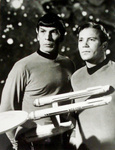
AMAZING STAR TREK TYPE TRANSLATOR ALLOWS YOU TO SPEAK IN 26 LANGUAGES
Terrance Aym
When the popular television series "Star Trek" debuted in the Fall of 1966, one of the many futuristic gadgets the crew of the Starship Enterprise had at its disposal was a fascinating little gizmo called a "universal translator." The device helped Kirk, Spock and crew communicate with alien races, since most green blobs and lizard people don't speak English. The translator became like the Holy Grail to many software engineers looking to make 23rd Century technology available today.
Now two brilliant software engineers have succeeded. Just such a translator-that converts any one of 26 pre-programmed spoken languages virtually real-time into any of the other 25 languages has been successfully created and demonstrated by Frank Soong and Rick Rashid.
The software is so advanced it actually permits the translated speech to speak another language in the users own voice.
Over the years other products have sought to achieve the status of a universal translator with varying degrees of success. Text conversion from one language to another has been available for many years. Although that was quite an achievement in itself, the creation of a real audio translator that permits two people speaking foreign tongues to speak into a machine that translates the conversation back and forth so both understand the others responses was the ultimate goal.
Influenced to a great degree by the famous science fiction show, many software engineers burned the late night oil trying to figure out the massive programming allowing such a machine to become reality.
Internet giant Google embarked on such a project during 2010 seeking to create a software application for its Android smartphones. The engineers ran into one stumbling block after another.
The difficulty with creating a workable universal translator is achieving a real-time or nearly real-time capability and the intense programming needed to create a reliable piece of software that has a very sophisticated artificial intelligence element that can learn and adapt its programming to user needs and parameter. very advanced speech recognition is also something that must be integrated into the translator in such a way that the entire process operates seamlessly.
Other attempts have been made. Industry innovator Bale Fish has tried, as well as less ambitious attempts like the 400-phrase iPhone application or a 63,000-word real-time translator that only translated one-way and then only one word at a time.
Until the breakthrough by Soon
and Rashid, the most ambitious-and popular-speech translater has been the ECTACO iTRAVL that the company touts as "The world’s most sophisticated Speech Recognition that understands exactly what you say and provides instant translation of words and phrases."
Its claim to fame is the software's ability to translate and speak up to 14,000 phrases by translating directly from the user's own spoken word. The video demonstrating the device is impressive.
Another current app, SpeechTrans claims it's the world's most advanced translator. This company likes to use acronyms and create high-tech imagery in the style of the space program. It boasts about its Language Translation System (LTS), Text-to-Speech (TTS) capability, and Speech-to-Speech (S2S) software.
Despite the whiz-bang, gee-whiz translators that a consumer can currently buy, the breakthrough beyond today's limitations is really one on an order of several magnitudes.
The new software can be converted into an app for any smartphone, works with 26 languages and allows seamless, real-time conversations.
During an interview with Technology Review, Soong said the software might be adapted to navigational devices working with GPS systems and be a boon for language students. Of course the obvious market is tourism, and to an extent, diplomats in the field.
"We will be able to do quite a few scenario applications.For a monolingual speaker traveling in a foreign country, we'll do speech recognition followed by translation, followed by the final text to speech output in a different language, but still in his own voice," Soong told Technology Review.
The device-researched and built at a Microsoft lab in Beijing, works exceedingly well and the userr's own voice is duplicated and recognizable, although it has a hint of tinniness.
Once the AI program familiarizes itself with the user's voice and phonetics, it can begin targeting words and phrases modeling the targeted language.
As this technology becomes the norm, careers as a human translator may go the way of the village blacksmith.

